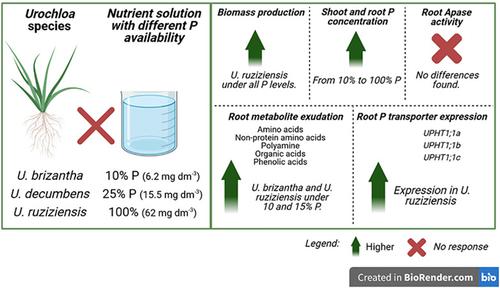当前位置:
X-MOL 学术
›
Ann. Appl. Biol.
›
论文详情
Our official English website, www.x-mol.net, welcomes your feedback! (Note: you will need to create a separate account there.)
Differential responses of three Urochloa species to low phosphorus availability
Annals of Applied Biology ( IF 2.6 ) Pub Date : 2021-03-30 , DOI: 10.1111/aab.12694 João Leonardo Corte Baptistella 1 , Juan Pablo Portilla Llerena 2 , Adilson Pereira Domingues‐Júnior 1 , Alisdair Robert Fernie 3 , José Laércio Favarin 1 , Paulo Mazzafera 1, 2
Annals of Applied Biology ( IF 2.6 ) Pub Date : 2021-03-30 , DOI: 10.1111/aab.12694 João Leonardo Corte Baptistella 1 , Juan Pablo Portilla Llerena 2 , Adilson Pereira Domingues‐Júnior 1 , Alisdair Robert Fernie 3 , José Laércio Favarin 1 , Paulo Mazzafera 1, 2
Affiliation

|
Urochloa (syn. Brachiaria spp.) is the most cultivated forage species in the tropics and is being introduced to agroecosystems as it can provide multiple services, such as nutrient cycling. In this regard, phosphorus (P) cycling has received particular attention for its little availability in soils and the fact that Urochloa has mechanisms to cope with its low availability. However, there are interspecific differences regarding adaptation to low fertility and P requirements among Urochloa species. This study aimed to evaluate the responses of three Urochloa species—Urochloa brizantha, Urochloa decumbens and Urochloa ruziziensis—to low P availability, as well as their mechanisms to grow on these conditions. We conducted a hydroponic experiment with three levels of P availability—10% (6.2 mg P dm−3), 25% (15.5 mg P dm−3) and 100% (62 mg P dm−3)—and evaluated plant biomass production, P tissue concentration, root acid phosphatase activity, root exudation and P transporter expression on roots. We identified several metabolites in root exudates including amino acids, non-protein amino acids, polyamides, organic acids and phenolic acids. Although all metabolites were found in all the species, metabolite exudation varied among species and P level. Overall, U. brizantha and U. ruziziensis plants exudated more metabolites when growing under P limitation (10 and 25% P), which can be a response to low P availability and stress. We identified three P transporters in roots from the PHT1 family—UPHT1;1a, UPHT1;1b and UPHT1;1c. We did not find an explicit expression pattern for UPHT1;1a, but the expression of UPHT1;1b and UPHT1;1c increased at low P availability. U. ruziziensis accumulated more biomass than the other species at all levels of P availability, possibly because of the greater expression of these P transporters. Urochloa species differ regarding nutrient availability requirements, including P, which may explain the P transporters expression and metabolite exudation results. Thus, to cope with low P in the soil, the species developed different metabolic strategies to improve the uptake of this nutrient.
中文翻译:

三种 Urochloa 物种对低磷有效性的不同反应
Urochloa(同义词Brachiaria spp.)是热带地区栽培最多的草料物种,由于它可以提供多种服务,例如养分循环,因此被引入农业生态系统。在这方面,磷 (P) 循环因其在土壤中的可用性很少而受到特别关注,并且Urochloa具有应对其低可用性的机制。然而,在Urochloa物种之间在适应低生育力和磷需求方面存在种间差异。本研究旨在评估三种Urochloa物种—— Urochloa brizantha、Urochloa decumbens和Urochloa ruziziensis 的反应——低磷可用性,以及它们在这些条件下生长的机制。我们进行了具有三个磷可用性水平的水培实验——10% (6.2 mg P dm -3 )、25% (15.5 mg P dm -3 ) 和 100% (62 mg P dm -3 )——并评估了植物生物质产量, P 组织浓度、根酸性磷酸酶活性、根系分泌物和 P 转运蛋白在根上的表达。我们在根系分泌物中鉴定了几种代谢物,包括氨基酸、非蛋白质氨基酸、聚酰胺、有机酸和酚酸。尽管在所有物种中都发现了所有代谢物,但代谢物渗出物因物种和磷水平而异。总体而言,U. brizantha和U. ruziziensis在磷限制(10% 和 25% P)下生长时,植物会渗出更多的代谢物,这可能是对低磷可用性和胁迫的一种反应。我们确定了在从根部三个P转运PHT1家族- UPHT1; 1A,UPHT1;图1b和UPHT1; 1C。我们没有发现UPHT1;1a的明确表达模式,但UPHT1;1b和UPHT1;1c的表达在低 P 可用性下增加。U. ruziziensis在所有 P 可用性水平上比其他物种积累了更多的生物量,可能是因为这些 P 转运蛋白的表达更高。尿绿不同物种在营养可用性要求方面存在差异,包括 P,这可以解释 P 转运蛋白的表达和代谢物渗出结果。因此,为了应对土壤中的低磷,该物种制定了不同的代谢策略来提高这种养分的吸收。
更新日期:2021-03-30
中文翻译:

三种 Urochloa 物种对低磷有效性的不同反应
Urochloa(同义词Brachiaria spp.)是热带地区栽培最多的草料物种,由于它可以提供多种服务,例如养分循环,因此被引入农业生态系统。在这方面,磷 (P) 循环因其在土壤中的可用性很少而受到特别关注,并且Urochloa具有应对其低可用性的机制。然而,在Urochloa物种之间在适应低生育力和磷需求方面存在种间差异。本研究旨在评估三种Urochloa物种—— Urochloa brizantha、Urochloa decumbens和Urochloa ruziziensis 的反应——低磷可用性,以及它们在这些条件下生长的机制。我们进行了具有三个磷可用性水平的水培实验——10% (6.2 mg P dm -3 )、25% (15.5 mg P dm -3 ) 和 100% (62 mg P dm -3 )——并评估了植物生物质产量, P 组织浓度、根酸性磷酸酶活性、根系分泌物和 P 转运蛋白在根上的表达。我们在根系分泌物中鉴定了几种代谢物,包括氨基酸、非蛋白质氨基酸、聚酰胺、有机酸和酚酸。尽管在所有物种中都发现了所有代谢物,但代谢物渗出物因物种和磷水平而异。总体而言,U. brizantha和U. ruziziensis在磷限制(10% 和 25% P)下生长时,植物会渗出更多的代谢物,这可能是对低磷可用性和胁迫的一种反应。我们确定了在从根部三个P转运PHT1家族- UPHT1; 1A,UPHT1;图1b和UPHT1; 1C。我们没有发现UPHT1;1a的明确表达模式,但UPHT1;1b和UPHT1;1c的表达在低 P 可用性下增加。U. ruziziensis在所有 P 可用性水平上比其他物种积累了更多的生物量,可能是因为这些 P 转运蛋白的表达更高。尿绿不同物种在营养可用性要求方面存在差异,包括 P,这可以解释 P 转运蛋白的表达和代谢物渗出结果。因此,为了应对土壤中的低磷,该物种制定了不同的代谢策略来提高这种养分的吸收。


























 京公网安备 11010802027423号
京公网安备 11010802027423号